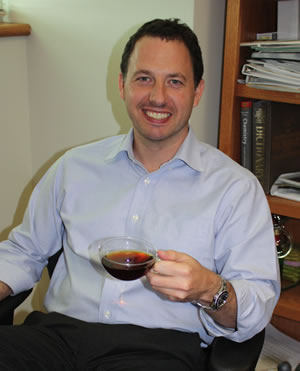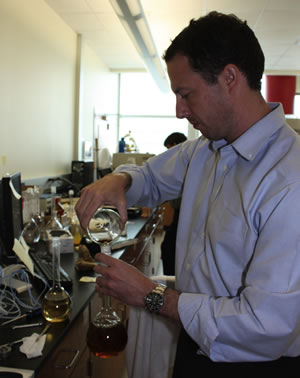It’s Scien-tea-fic
By Ashley Festa
Dr. Brian McBurnett’s love of tea began more than 16 years ago, when he wandered into a tea shop in San Francisco's Chinatown. The young woman working in the shop introduced him to the different flavors of tea and showed him the different types of teapots. Today, he’s working toward publishing the results of his research on tea. And he still keeps in touch with Annie in the tea shop.

McBurnett, associate professor of chemistry, is so crazy about tea that he serves it to his students during his office hours.
“I have my little teapot,” he said with a grin as he lifted the pot from beside his desk. And he loves all the differences and nuances in the world of tea. “There are some teapots that absorb all the tea so after 10 years, you can make tea by just adding water to the pot. It’s a special clay from China.”
He has been researching tea since he came to UIW four years ago. The National Cancer Institute studies tea for its anticarcinogenic properties, and McBurnett realized that his personal interest in tea could be used to help people. He now works to reduce the inconsistencies in tea studies so they can be more reliable.
He isolates the different variables used in the preparation, such as the temperature of the water, the number of tea leaves, the amount of time it brews and the number of infusions. He studies the difference between the use of loose leaf tea versus ground tea, and he says it’s also important that he knows the origin of the tea. For his research, McBurnett uses tea imported from China to the shop in San Francisco so he knows exactly where it comes from and how it’s grown.
“It’s really nuts how specific it can get,” he said.

Dr. Brian McBurnett mixes an infusion of tea for analysis in a UIW laboratory.
In his studies, McBurnett particularly is interested in antioxidants and infusions, which is the number of times the tea is brewed. All the different kinds of tea in the world come from just one type of plant, he explained. White tea, green tea, oolong tea and black tea are all picked from the same type of plant; it’s only the amount of oxidation in the leaves that makes the teas different.
And it’s the levels of oxidation that make some teas more interesting for the National Cancer Institute because antioxidants have proven effects against cancer. For example, most people know that green tea is supposed to be “good for you,” but why is that the case? It’s because of the level of antioxidants, McBurnett explained. Black tea has more oxidation, and therefore fewer antioxidants, than green tea, which is why it does not have the same cancer-preventing properties.
Tea is the most popular beverage in the world after water, McBurnett quoted from his research, and more than half the world’s population drinks it. But it’s not only hot tea that provides antioxidants.
“People don’t drink hot tea in this country. They drink Bill Miller tea like it’s going out of style,” McBurnett joked. “But iced tea has health benefits, too.”
However, it’s still the green tea that provides the most benefit, even in iced tea.
During his studies, McBurnett has made several conclusions.
“Loose leaf tea tastes better,” he said matter-of-factly. But more importantly, he’s found that keeping other variables equal, the second infusion of the tea releases the most antioxidants, and therefore has the most health benefit potential.
